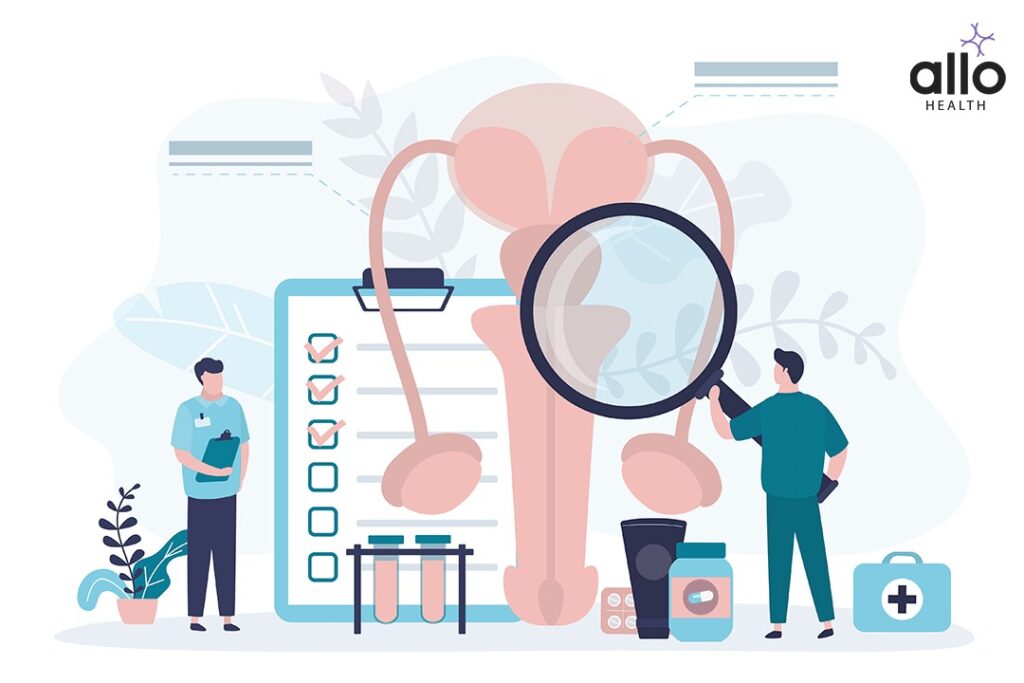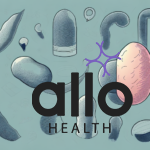Male Reproductive Organs

Allo Health is dedicated to personalized well-being, offering support and trusted information tailored to individual health goals. The platform emphasizes human-generated content, led by a distinguished medical team of experts, including physicians and sexual health specialists. Their commitment to credibility involves rigorous fact-checking, authoritative research, and continuous updates to ensure accurate, up-to-date information. Allo Health's unique approach goes beyond conventional platforms, providing expert-led insights and a continuous commitment to excellence, with user feedback playing a crucial role in shaping the platform's authoritative voice.

A Psychotherapist with Clinical specialization, working for over seven years now. Areas of specialization range from Anxiety-related disorders, Mood-related disorders, Personality disorders, Sexual dysfunctions & other mental health issues.
Why This Was Upated?
Our experts continually monitor the health and wellness space, and we update our articles when new information became available.
Updated on 18 April, 2024
- Article was updated as part of our commitment to diversity, equity, and inclusion.

"The following blog article provides general information and insights on various topics. However, it is important to note that the information presented is not intended as professional advice in any specific field or area. The content of this blog is for general educational and informational purposes only.
Book consultation
The content should not be interpreted as endorsement, recommendation, or guarantee of any product, service, or information mentioned. Readers are solely responsible for the decisions and actions they take based on the information provided in this blog. It is essential to exercise individual judgment, critical thinking, and personal responsibility when applying or implementing any information or suggestions discussed in the blog."
Organs Of The Male Reproductive System
The male reproductive system is the system responsible for producing and transporting sperm and semen, as well as the delivery of sperm during sexual intercourse. It consists of the testes, which are the primary source of sperm and the male hormone testosterone; the vas deferens, which transports sperm from the testes to the urethra; the seminal vesicles, which produce a fluid that nourishes and protects the sperm; the prostate gland, which also contributes to semen production; and the penis, which delivers semen during ejaculation. The scrotum, which houses the testes, helps to regulate their temperature for proper sperm production.
Male Reproductive Organs
External Organs
The male reproductive system plays a vital role in human reproduction. It consists of several internal and external organs that work together to produce, store, and transport sperm. In this article, we’ll focus on the external organs of the male reproductive system.
Penis
The penis is the external organ that is most commonly associated with the male reproductive system. It is a cylindrical-shaped organ that is made up of three main parts: the root, shaft, and glans. The root of the penis is attached to the pelvic bone and the shaft is the long, cylindrical part of the penis. The glans is the rounded tip of the penis, which is also known as the head. The penis is responsible for transferring semen from the body during ejaculation.
Bulbourethral Glands
The male reproductive system is composed of different structures that work together to produce and transport sperm for fertilization. The bulbourethral glands, also known as Cowper’s glands, are two small glands located at the base of the penis. Despite their small size, the bulbourethral glands play a crucial role in the male reproductive system by producing a lubricating fluid that is essential for successful sexual intercourse.
Anatomy
The bulbourethral glands are located on either side of the urethra, just below the prostate gland. They are pea-sized and each gland is about 1.5 cm long and 0.5 cm wide. The glands are covered by a layer of connective tissue, which contains small blood vessels and nerves. Each gland has a single duct that opens into the urethra.
Function
The bulbourethral glands secrete a clear, viscous fluid that is released during sexual arousal. This fluid is commonly known as pre-ejaculate or pre-cum, and it plays several important roles in the male reproductive system. Firstly, the fluid helps to lubricate the urethra and neutralize any acidic urine that may be present, creating a more hospitable environment for the sperm. Secondly, the fluid contains enzymes that can help to break down any remaining urine or other substances in the urethra that may be harmful to the sperm. Finally, the pre-ejaculate can also help to enhance sexual pleasure by reducing friction during intercourse.
Regulation
The secretion of the bulbourethral fluid is regulated by the parasympathetic nervous system. During sexual arousal, the parasympathetic nerves release a neurotransmitter called acetylcholine, which stimulates the bulbourethral glands to secrete their fluid. The amount of fluid produced can vary widely between individuals, but on average it is estimated to be between 0.1 and 0.5 milliliters.
Clinical significance
The bulbourethral glands are relatively small and often overlooked, but they can play an important role in male reproductive health. For example, infections or inflammation of the glands can cause pain, swelling, or discomfort during sexual activity. In some cases, the ducts of the glands can become blocked, leading to a buildup of fluid and a condition known as Cowper’s duct cyst. In rare cases, tumors or other growths can develop within the gland tissue.
The bulbourethral glands are a small but important component of the male reproductive system. Their secretions play a crucial role in lubricating the urethra, neutralizing acidic urine, and enhancing sexual pleasure. Although the glands are typically healthy and function normally, they can be subject to a variety of conditions that can affect male reproductive health.
Scrotum
The scrotum is a sac-like structure that is located behind the penis. It contains the testes, which are the male reproductive glands that produce sperm and testosterone. The scrotum is responsible for regulating the temperature of the testes, which is important for sperm production. It also helps to protect the testes from damage and injury.
Spermatic cord
The spermatic cord is an essential anatomical structure in the male reproductive system, comprising multiple components, including blood vessels, nerves, lymphatics, and the vas deferens. This cord serves as the conduit for the transportation of sperm from the testes to the urethra for ejaculation during sexual intercourse. In this article, we will discuss the anatomy, function, and clinical significance of the spermatic cord.
Anatomy of the Spermatic Cord
The spermatic cord is a bundle of tissue that extends from the abdominal cavity through the inguinal canal to the scrotum. It is about 15-20 cm long and 1 cm in diameter. The cord contains three layers of tissue that envelop its contents, including the vas deferens, testicular artery, veins, lymphatics, and nerves.
The outer layer is the external spermatic fascia, a continuation of the external oblique muscle aponeurosis that covers the entire length of the cord. The middle layer is the cremasteric fascia, derived from the internal oblique muscle, which surrounds the spermatic cord and the testis. The innermost layer is the internal spermatic fascia, which is derived from the transversalis fascia.
The contents of the spermatic cord include the vas deferens, which carries sperm from the epididymis to the ejaculatory duct, testicular artery, pampiniform plexus of veins, lymphatics, and the genital branch of the genitofemoral nerve.
Function of the Spermatic Cord
The spermatic cord is responsible for the transport of sperm from the testes to the urethra for ejaculation during sexual intercourse. It is also responsible for the blood supply to the testes, lymphatic drainage, and nerve supply.
The vas deferens is the primary component responsible for transporting sperm from the testes to the urethra. The testicular artery provides the blood supply to the testes, while the pampiniform plexus of veins functions in venous return from the testes. The lymphatics are responsible for the drainage of lymph fluid from the testes to the inguinal lymph nodes. Finally, the genital branch of the genitofemoral nerve provides sensory innervation to the scrotum and the cremaster muscle, which helps regulate the temperature of the testes.
Clinical Significance of the Spermatic Cord
The spermatic cord is a crucial structure in the male reproductive system, and its pathology can lead to severe complications. Some of the clinical conditions that affect the spermatic cord include testicular torsion, inguinal hernia, epididymitis, and varicocele.
- Testicular torsion is a condition in which the testes rotate around the spermatic cord, resulting in a sudden loss of blood flow to the testes. It is a medical emergency that requires prompt surgical intervention to prevent permanent damage to the testes.
- Inguinal hernia is a condition where a part of the small intestine protrudes through a weakness in the abdominal wall, passing through the inguinal canal and into the scrotum. This can cause pain, swelling, and discomfort in the scrotum and requires surgical repair.
- Epididymitis is an inflammation of the epididymis, which is a coiled tube that stores and carries sperm from the testes. It can cause pain, swelling, and discomfort in the scrotum, and is usually treated with antibiotics.
- Varicocele is a condition in which the veins in the pampiniform plexus become enlarged, leading to impaired blood flow to the testes. It can cause pain, swelling, and infertility in some cases, and may require surgical intervention.
Pubic Hair
Pubic hair is a type of hair that grows in the pubic area and is an important part of the male reproductive system. It provides a cushion and protection for the external genitalia and helps to reduce friction during sexual activity.
Urethral Meatus
The urethral meatus is the opening through which urine and semen are expelled from the body. It is located at the tip of the penis and is surrounded by the glans. The urethral meatus is an important part of the male reproductive system as it allows for the release of semen during ejaculation.
Internal Organs
Testes
The testes, also known as testicles, are the primary male reproductive organs responsible for producing and storing sperm. They are also the primary source of testosterone, the hormone that regulates male sexual development and function.
Leydig cells (LC)
Leydig cells are the primary source of testosterone in males and play a crucial role in the development and maintenance of male reproductive function. These cells are located in the interstitial tissue of the testes, also known as the Leydig cell zone.
Structure of Leydig Cells
Leydig cells are large, polyhedral-shaped cells that have a prominent nucleus and abundant cytoplasm. They contain numerous mitochondria, which are responsible for the production of testosterone. Leydig cells also have a smooth endoplasmic reticulum, which is involved in the synthesis of cholesterol and the conversion of cholesterol to testosterone. The smooth endoplasmic reticulum forms a network of tubules and vesicles that are distributed throughout the cytoplasm of the cell.
Function of Leydig Cells
Leydig cells play a vital role in the development and maintenance of male reproductive function. They produce testosterone, a hormone that is responsible for the development of male secondary sexual characteristics such as muscle mass, facial hair, and a deeper voice. Testosterone also stimulates the production of sperm in the testes.
Leydig cells are regulated by luteinizing hormone (LH), which is produced by the anterior pituitary gland. LH binds to receptors on the surface of Leydig cells, which stimulates the production of testosterone. LH is regulated by gonadotropin-releasing hormone (GnRH), which is produced by the hypothalamus.
Regulation of Leydig Cells
The regulation of Leydig cells is a complex process that involves the hypothalamic-pituitary-gonadal (HPG) axis. GnRH is produced by the hypothalamus and travels to the anterior pituitary gland, where it stimulates the production of LH. LH is released into the bloodstream and travels to the testes, where it binds to receptors on the surface of Leydig cells. This binding stimulates the production of testosterone.
Testosterone has a negative feedback effect on the HPG axis. When the levels of testosterone in the blood increase, they inhibit the production of GnRH and LH, which in turn reduces the production of testosterone. This negative feedback loop helps to maintain a stable level of testosterone in the blood.
Leydig cells play a crucial role in the development and maintenance of male reproductive function. They produce testosterone, a hormone that is responsible for the development of male secondary sexual characteristics and the stimulation of sperm production. The regulation of Leydig cells is a complex process that involves the hypothalamic-pituitary-gonadal axis. Understanding the structure, function, and regulation of Leydig cells is important for the diagnosis and treatment of male reproductive disorders.
Germ cells
These are the type of cell that gives rise to spermatozoa or ova, the reproductive cells that allow for the transmission of genetic information from one generation to the next. In males, germ cells are located in the testes and undergo a complex process of development and differentiation to form mature spermatozoa capable of fertilizing ova.
Anatomy and Function of Germ Cells
Germ cells are located within the testes, specifically in the seminiferous tubules. These tubules are lined with a specialized type of cell called the Sertoli cell, which provides structural and nutritional support to the developing germ cells.
Germ cells are responsible for the production of spermatozoa, which is the male reproductive cell. They undergo a complex process of development and differentiation known as spermatogenesis, which involves multiple stages of cell division and differentiation.
During spermatogenesis, germ cells undergo two types of cell division: mitosis and meiosis. Mitosis is responsible for the expansion of the germ cell population, while meiosis is responsible for the production of haploid spermatozoa.
The process of spermatogenesis is regulated by a complex interplay of hormones, growth factors, and other signaling molecules. These molecules act on the germ cells to promote their proliferation and differentiation, as well as to modulate the activity of the supporting Sertoli cells.
Developmental Pathway of Germ Cells
Germ cells in the male reproductive system originate from primordial germ cells (PGCs), which arise early in embryonic development. These PGCs migrate from their site of origin in the yolk sac to the genital ridge, where they differentiate into gonocytes, the embryonic precursors of spermatozoa.
Gonocytes divide rapidly in the fetal testes, giving rise to a population of germ cells that will eventually become spermatozoa. As these cells divide, they differentiate into spermatogonia, the first cells in the spermatogenic lineage.
Spermatogonia undergo a series of mitotic divisions to generate primary spermatocytes, which then undergo meiosis I to produce two secondary spermatocytes. These cells then undergo meiosis II to produce four haploid spermatids, which differentiate into mature spermatozoa.
Regulation of Germ Cell Development
The process of germ cell development is regulated by a complex interplay of signaling pathways that involves a variety of hormones and growth factors.
One of the most important hormones involved in germ cell development is testosterone, which is produced by the Leydig cells in the testes. Testosterone acts on the germ cells to promote their proliferation and differentiation, as well as to modulate the activity of the supporting Sertoli cells.
Other important signaling molecules involved in germ cell development include follicle-stimulating hormone (FSH) and luteinizing hormone (LH), which are produced by the pituitary gland. FSH acts on the Sertoli cells to promote the maturation of the germ cells, while LH stimulates the Leydig cells to produce testosterone.
Germ cells are a critical component of the male reproductive system, responsible for the production of spermatozoa and the transmission of genetic information from one generation to the next. Their development and differentiation are tightly regulated by a complex interplay of hormones and growth factors, and any disruptions to this regulatory system can lead to a variety of developmental abnormalities.
Understanding the biology of germ cells is essential for developing effective treatments for male infertility and other reproductive disorders, and ongoing research in this area is likely to yield important insights into the mechanisms that underlie the
Epididymis
The epididymis is a coiled tube that sits on top of the testes and serves as a storage site for sperm. Sperm mature and become more motile as they pass through the epididymis.
Vas Deferens
The vas deferens is a muscular tube that connects the epididymis to the urethra. It carries sperm from the epididymis to the urethra during ejaculation.
Seminal Vesicles
The seminal vesicles are small glands located near the base of the bladder that produce a thick, nutritious fluid that mixes with sperm to form semen.
Prostate Gland
The prostate gland is a small, muscular gland located near the base of the bladder that surrounds the urethra. It produces a fluid that helps to protect and nourish sperm as it travels through the urethra and into the female reproductive tract.
Each of these internal organs plays a crucial role in the male reproductive process, and concerns with any one of them can result in infertility or other reproductive concerns. It is important for men to maintain their reproductive health by engaging in healthy behaviors, such as avoiding tobacco and excessive alcohol consumption, and seeking medical attention if they experience any reproductive symptoms or concerns.
Medical Conditions Affecting Male Reproductive Organs
The male reproductive system is an important part of the male body responsible for the production and delivery of sperm for fertilization of the female egg. Like all parts of the body, the male reproductive organs are prone to medical conditions that can affect their normal function. In this article, we will explore some of the medical conditions that affect the male reproductive organs.
Erectile Dysfunction (ED)
Erectile dysfunction is a common condition that affects many men worldwide. ED is the inability to achieve or maintain an erection firm enough for sexual intercourse. Causes of ED can be physical, psychological or a combination of both. Physical causes include high blood pressure, heart disease, diabetes, and hormonal imbalances. Psychological factors such as stress, anxiety, and depression can also cause ED. Treatment options include medication, lifestyle changes, and psychological counseling.
Prostate Cancer
Prostate cancer is a common cancer that affects men, especially those over the age of 50. The prostate gland is a small gland located in front of the rectum and produces fluid that nourishes and protects sperm. The symptoms of prostate cancer include difficulty urinating, frequent urination, and blood in the urine. Treatment options include surgery, radiation therapy, and chemotherapy.
Testicular Cancer
Testicular cancer is a relatively rare cancer that can affect men in their 20s and 30s. The testicles are responsible for the production of sperm and testosterone. The symptoms of testicular cancer include a painless lump or swelling in the testicles, and a feeling of heaviness or discomfort in the scrotum. Treatment options include surgery, radiation therapy, and chemotherapy.
Varicocele
A varicocele is a condition in which the veins in the scrotum become enlarged and twisted, causing a pooling of blood in the testicles. Varicoceles are a common cause of male infertility and can also cause pain or discomfort in the scrotum. Treatment options include surgery and embolization, a procedure in which a substance is injected into the veins to block blood flow.
Epididymitis
Epididymitis is an inflammation of the epididymis, a coiled tube located behind the testicles that stores and transports sperm. The most common cause of epididymitis is a bacterial infection. Symptoms include pain and swelling in the scrotum, fever, and painful urination. Treatment options include antibiotics, pain medication, and rest.
The male reproductive system is prone to a variety of medical conditions that can affect its normal function. Some of these conditions, such as ED and varicocele, can be treated with medication or surgery. Others, such as prostate and testicular cancer, require more aggressive treatment options such as surgery, radiation therapy, and chemotherapy. It is important for men to be aware of the symptoms of these conditions and seek medical attention if they experience any unusual symptoms.
Prostatic Hyperplasia
Prostatic hyperplasia, also known as benign prostatic hyperplasia (BPH), is a common condition that affects men as they age. It is characterized by an enlargement of the prostate gland, which can cause a range of urinary symptoms. In this research article, we will provide a detailed overview of BPH, including its causes, symptoms, diagnosis, and treatment options.
Causes of Prostatic Hyperplasia
The exact cause of BPH is not fully understood. However, several factors are thought to contribute to the development of the condition, including hormonal imbalances, age-related changes in the prostate, and genetics. Androgens, such as testosterone, play a crucial role in the growth and development of the prostate gland. As men age, their testosterone levels decrease, while the levels of estrogen and other hormones increase, leading to an enlargement of the prostate gland.
Symptoms of Prostatic Hyperplasia
The symptoms of BPH can vary in severity, and not all men with an enlarged prostate will experience symptoms. The most common symptoms of BPH include:
- Frequent urination, especially at night (nocturia)
- Urgency to urinate
- Weak urine flow
- Difficulty starting urination
- Straining to urinate
- Incomplete emptying of the bladder
- Urinary retention
- Urinary tract infections (UTIs)
Diagnosis of Prostatic Hyperplasia
To diagnose BPH, a healthcare provider will typically perform a physical examination and take a medical history. They may also order diagnostic tests, such as a digital rectal exam (DRE), a prostate-specific antigen (PSA) blood test, or a urine flow test. Imaging studies, such as ultrasound, may also be used to evaluate the size and structure of the prostate gland.
Treatment of Prostatic Hyperplasia
There are several treatment options available for BPH, depending on the severity of the symptoms and the size of the prostate gland. These include:
- Watchful waiting: For mild to moderate cases of BPH, a healthcare provider may recommend watchful waiting or active surveillance. This involves regular monitoring of the condition, without immediate intervention.
- Medications: Medications, such as alpha-blockers and 5-alpha reductase inhibitors, can help to reduce the size of the prostate gland and relieve symptoms of BPH. These drugs work by relaxing the smooth muscles of the prostate gland and reducing the levels of certain hormones.
- Minimally invasive procedures: In some cases, minimally invasive procedures may be recommended to treat BPH. These procedures, such as transurethral resection of the prostate (TURP), involve removing the excess tissue from the prostate gland using a special tool inserted through the urethra.
- Surgery: For severe cases of BPH, surgery may be necessary to remove the enlarged prostate gland. This procedure, known as a prostatectomy, can be performed using various techniques, including open surgery or minimally invasive robotic-assisted surgery.
Testicular Atrophy
Testicular atrophy is a condition in which the testicles shrink in size, resulting in reduced hormone production and sperm production. It can be caused by a variety of factors, including injury, infection, and hormonal imbalances. This article will discuss the causes, symptoms, and treatments for testicular atrophy.
Causes of Testicular Atrophy
There are many causes of testicular atrophy, including aging, injury, infection, hormonal imbalances, and certain medical conditions. As men age, their testicles naturally shrink in size, and the production of testosterone and sperm decreases. Injury to the testicles, such as from trauma or surgery, can also cause testicular atrophy. Infections, such as mumps, can lead to inflammation of the testicles, which can cause them to shrink. Hormonal imbalances, such as low levels of testosterone, can also result in testicular atrophy. Certain medical conditions, such as Klinefelter syndrome and hemochromatosis, can also cause the testicles to shrink.
Symptoms of Testicular Atrophy
The symptoms of testicular atrophy can vary depending on the cause and severity of the condition. In some cases, there may be no symptoms at all. However, some common symptoms of testicular atrophy include a decrease in testicle size, reduced sperm production, and a decrease in testosterone production. Men with testicular atrophy may also experience a decrease in libido, muscle mass, and bone density. In some cases, they may also experience erectile dysfunction and depression.
Treatments for Testicular Atrophy
The treatment for testicular atrophy depends on the underlying cause of the condition. In some cases, no treatment may be necessary. For example, if the condition is caused by aging, there may be no way to reverse the effects of the condition. However, if the condition is caused by an infection, such as mumps, antibiotics may be prescribed to treat the infection and reduce inflammation. Hormone therapy, such as testosterone replacement therapy, may be prescribed to help increase testosterone levels and improve symptoms. Surgery may also be necessary in some cases, such as if the condition is caused by a tumor or injury.
Sex Hormones In The Male Reproductive System
The male reproductive system plays a crucial role in sexual reproduction by producing and delivering sperm to the female reproductive tract. The process of male reproduction is controlled by sex hormones, primarily testosterone, which is produced in the testes. These hormones play a significant role in the development, function, and maintenance of the male reproductive system.
Testosterone
Testosterone is the primary sex hormone in males, which is responsible for the development and maintenance of male reproductive organs, secondary sexual characteristics, and reproductive functions. The testes produce testosterone in response to luteinizing hormone (LH), which is released by the pituitary gland. Testosterone levels are highest during puberty, where it triggers the growth and development of male reproductive organs and secondary sexual characteristics such as facial hair, deepening of the voice, and increased muscle mass.
Testosterone also plays a crucial role in the production of sperm, as it stimulates the production of sperm cells in the testes. It also regulates the production of other hormones, such as follicle-stimulating hormone (FSH), which is responsible for the production of sperm.
Other Sex Hormones
In addition to testosterone, other hormones also play a role in male reproductive function.
- Follicle-stimulating hormone (FSH) stimulates the production of sperm in the testes. Luteinizing hormone (LH) is responsible for the production of testosterone in the testes. Both of these hormones are released by the pituitary gland, which is located in the brain.
- Another hormone, prolactin, is produced by the pituitary gland and is responsible for regulating lactation in females. However, in males, it has been found to inhibit testosterone production and can lead to sexual dysfunction and infertility.
Functions of Sex Hormones in the Male Reproductive System
Sex hormones play a critical role in the development, function, and maintenance of the male reproductive system. Testosterone, in particular, is responsible for the development of male reproductive organs, secondary sexual characteristics, and sperm production. Testosterone also plays a significant role in regulating other hormones, such as FSH, which stimulates the production of sperm.
In addition to its reproductive functions, testosterone also plays a role in the maintenance of bone density and muscle mass, as well as the regulation of metabolism and mood.
Sex hormones, primarily testosterone, play a significant role in the development, function, and maintenance of the male reproductive system. These hormones are responsible for the growth and development of male reproductive organs and secondary sexual characteristics, as well as the production of sperm. Disorders of the male reproductive system can result in sexual dysfunction, infertility, and other health concerns. It is essential to understand the role of sex hormones in the male reproductive system to diagnose and treat these disorders effectively.







































